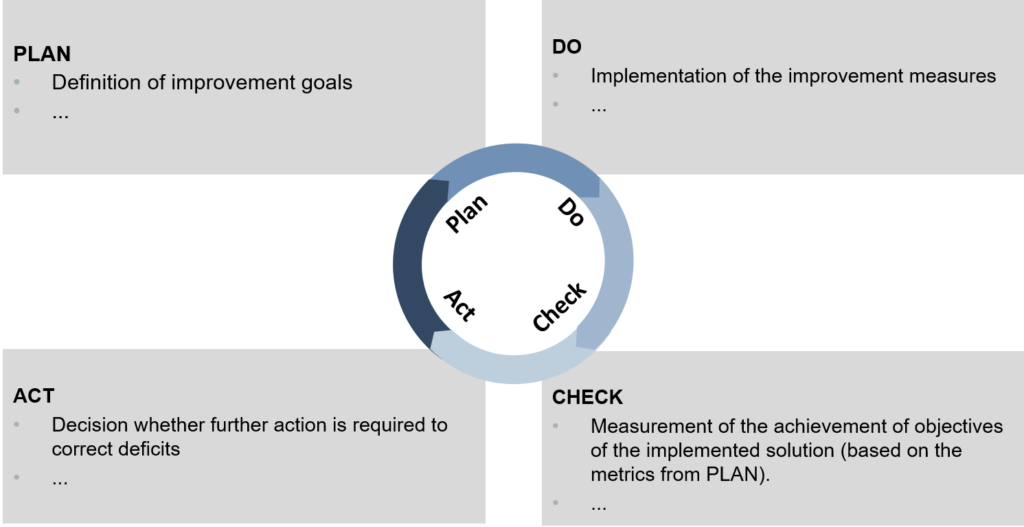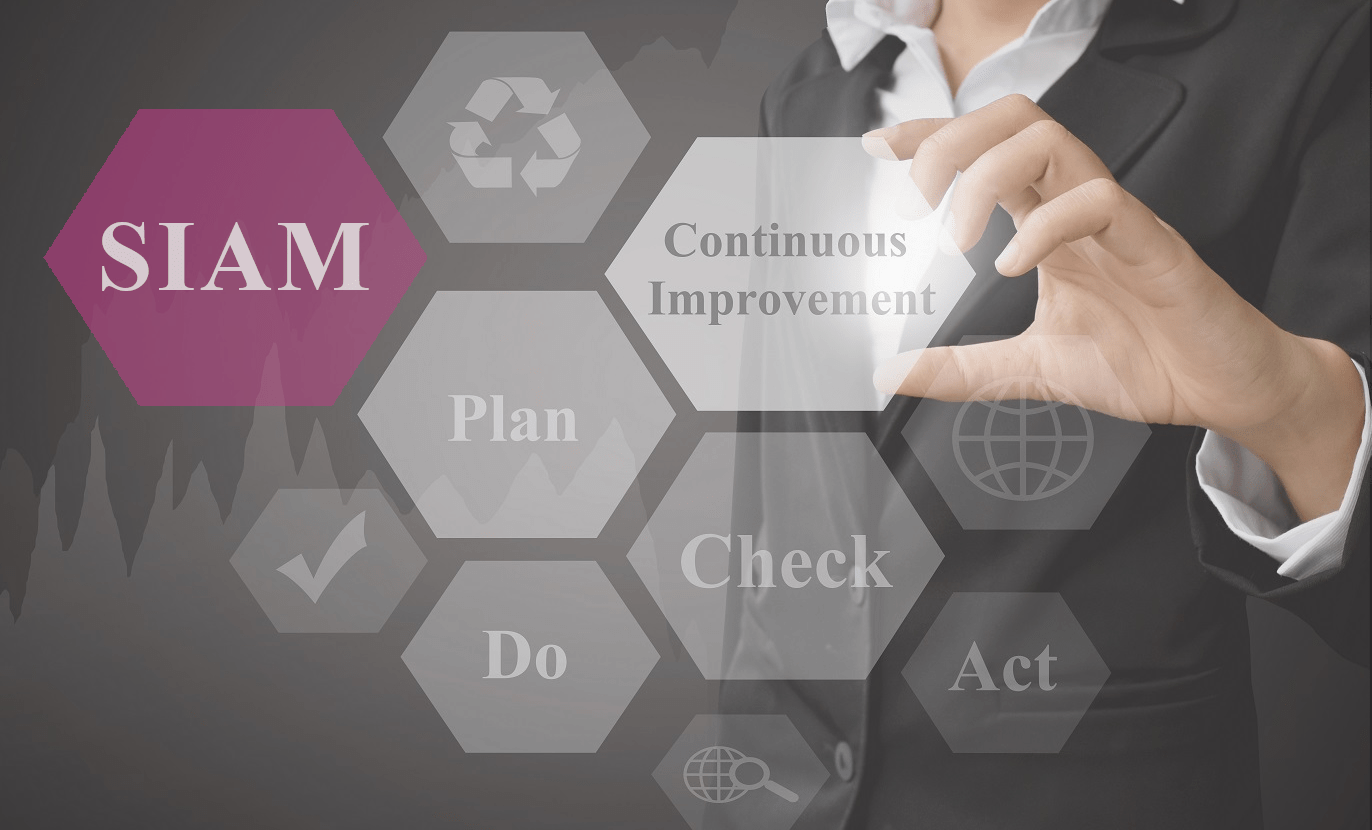Many companies use continual improvement (CI) to respond to ever changing requirements for services, products and processes and to be able to constantly offer their customers new benefits. All organizational units, including service provider management, are now facing these challenges, especially when they are aligned with Service Integration and Management (SIAM). In today’s blog post, we would like to show you how to implement Continual Improvement in SIAM environments after a successful IT outsourcing.
Initial situation
After an IT outsourcing has taken place, it can happen that the services provided initially deteriorate because the relevant external service providers are in a “learning phase”. This can quickly lead to dissatisfaction within the organization of the outsourcing company and even to strong resistance toward the external service providers. Cooperation, let alone continual improvement, is out of the question. How can we avoid this kind of resistance formation and solidifying dissatisfaction with the external services? How can we, instead, work together with the service providers to initiate an improvement process that will steadily increase the quality of the services? Summarizing: How can we implement Continual Improvement in SIAM environments?
Requirements
Code of Conduct
In our view, it is crucial to lay the foundation for a culture of continual improvement even before the outsourcing begins. This includes not only the continual improvement of services, but also of processes and collaboration. The basis for this is a code of conduct, to be defined in the phase of designing the overarching outsourcing concept. This code applies equally to all service providers.
Continual Improvement Process
In this phase, it is also important to define the rough processes for continual improvement, which also apply to all service providers. In a multi-provider environment in particular, it should be ensured that all providers implement the same processes to guarantee a smooth collaboration. In the bidding phase, care should be taken to ensure that bidders already specify in their bids approaches to solutions, as to how they intend to implement the required continual improvement process in their organization in practice. The customer, however, ultimately determines the final design of the processes. The latter are then in turn binding for all providers. Process sovereignty therefore remains with the service integrator. The individual providers have room for adaptation within their own organization, but without affecting cooperation with other providers. During the bidding discussions, it is important to clarify whether both sides have developed the same understanding of the CI process and the measures derived from it.
Contract Regulations
If this is the case, the contract to be concluded should include, in addition to the mutual commitment to continual improvement, the developed process specifications and their framework conditions. These should be at least the following:
- Methods to be applied, e.g., Deming Cycle, continual improvement model (ITIL)
- Managing costs and savings
- Responsibilities
- Control mechanisms
Common Understanding
In the transition phase, the standardized measures for CI are implemented in a binding manner both on the part of the service integrator and on the part of all providers and must then be filled with life. This is the only way to ensure the necessary cooperation between several providers in improvement activities. At this point at the latest, representatives of all parties should therefore conduct another review to determine whether a uniform understanding and handling has been achieved. If this is not the case, the CI process must be put to the test again at once.
Additionally, the following should be emphasized: A living continual improvement culture means that suggestions for improvement can and should be made at all levels, both on the provider and vendor management side but also by additional stakeholders. In this context, CI is not a one-time process, but should become part of the DNA of all stakeholders. To achieve this, widely visible support from management is indispensable.

Figure 1: Deming Cycle
Possible methods and measures
In order for CI to develop its potential to generate new benefits and meet changing requirements, it must become a living part of everyday operations. This can be achieved if CI is present as a process among all those involved. Below, some examples are shown of how this can be achieved.
1. Put CI on the agenda in all committees with (multi-)provider participation:
- Regularly at the end of each board meeting (operating board, service management board, …), the topic of CI is also placed on the agenda
- Identified and discussed weak points, further spontaneous ideas as well as improvement approaches are documented in a CI list
2. Establish CI committee with relevant service providers that meets on a regular basis:
- (Updated) evaluation of the suggestions in CI list.
- Prioritize suggestions for improvement, ensuring that prioritization is transparent and understandable to all
- Identify quick wins and move quickly to implementation (serves as a visible motivational boost for all involved) – this also applies to low-cost/low-effort initiatives
- Initiate measures with high prioritization
- Initiate the development of improvement approaches (see point 4)
3. Make CI list directly or indirectly accessible to all stakeholders:
- Create the possibility of recording all forms of feedback and ideas and transferring them to the CI list; for this purpose, it may be necessary to set up different channels (e.g., mail account, CI contact person, CI mailbox)
- At the same time, constantly signal to all participants that their suggestions for improvement are important and desired
4. Run regular workshops with the following agenda:
Use of creative techniques to identify and concretize further suggestions for improvement (and their inclusion in CI list), e.g.
- Design Thinking
- Creative Spaces
- other creativity techniques
5. Use agile methods to implement the areas of improvement:
To achieve steady results, it makes sense to break down complex improvement measures into several small and self-contained packages and implement them using agile methods. Suitable methods for this are e.g.:
- Kanban
- Kaizen
- Lean Six Sigma
- Scrum
6. Review improvement measures in CI committee (see point 2)
- creating a lessons learned log can be helpful to document experiences from improvement initiatives and use them for later initiatives
- Regular review of the CI process itself by asking questions such as:
- Were the methods used helpful?
- What was a hindrance?
- What was beneficial?
7. Active marketing of the improvements
The results of the improvement initiatives should be used to further solidify the commitment to continual improvement among all external providers, vendor management staff and other stakeholders involved. This can be done by actively marketing the successes achieved to date.
In this way, for example, good results help increase the acceptance of outsourcing, external providers and the retained organization among internal stakeholders within the customer’s organization. Successful financial savings can be linked to a savings split between the client and providers, to be agreed in advance in the contract. In this way, costs can also be reduced for the customer. The positive effects of the improvements, in turn, are an incentive to continue the CI process.
The external providers can also benefit from successes achieved. They can transfer the experience gained to other customers and thus increase their reputation and revenue there. The transfer of rights to certain improvement-related innovations could also be an incentive and motivational boost to continue in the direction taken. The same applies to positive feedback from internal and external customers. In this way, the goal of making CI a self-evident part of joint work can gradually be achieved.
Bottom line – Continual Improvement in SIAM
In practice, Continual Improvement in SIAM environments is unfortunately still far too rare. A well-established CI helps the service integrator and the external providers to continuously improve services and processes and to continuously increase the benefits of the services for the customers. However, it is not only the services offered that improve, but also the cooperation between all those involved, because this is also the subject of continual improvement. In this way, the introduction of CI in a SIAM environment ultimately also helps to promote a culture of cooperation based on trust, which ultimately benefits all those involved.







